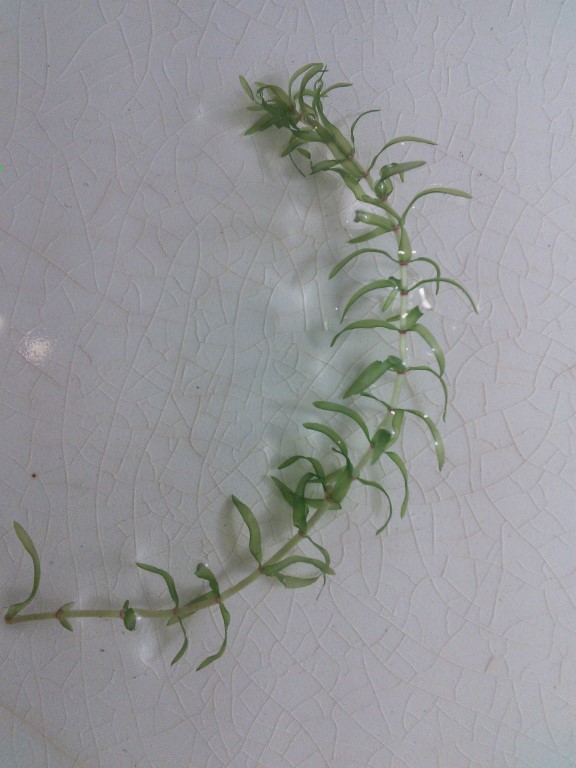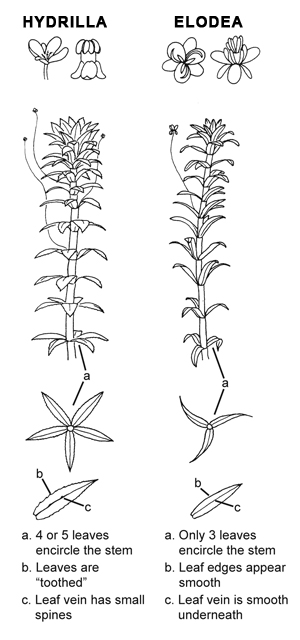 Last week I noticed some large and extensive mats of a green pond weed over by my shoreline in about 2′-3′ of water, thick enough to foul my trolling motor and bring my boat to a halt. I collected a sample and identified it as Elodea or American water weed (or Common Pond Weed). I was therefore not particularly surprised when Thomas Gillette showed up at my house yesterday with a shopping bag full of this plant, concerned that Clary Lake might have an invasive plant infestation underway. Thomas told me that Butch Duncan had brought it to him, saying that there were thick mats of it over in the cove on the north side of the lake by Duncan Road.
Last week I noticed some large and extensive mats of a green pond weed over by my shoreline in about 2′-3′ of water, thick enough to foul my trolling motor and bring my boat to a halt. I collected a sample and identified it as Elodea or American water weed (or Common Pond Weed). I was therefore not particularly surprised when Thomas Gillette showed up at my house yesterday with a shopping bag full of this plant, concerned that Clary Lake might have an invasive plant infestation underway. Thomas told me that Butch Duncan had brought it to him, saying that there were thick mats of it over in the cove on the north side of the lake by Duncan Road.
 I reassured Thomas that this was not an invasive species. We’ve had this plant growing in Clary Lake forever but it’s always remained under control. You’d see a few pieces of it wash ashore from time to time or you might see patches of it up in the channel. Recently however, conditions around the lake have become quite conducive to this plant’s rapid growth in areas where it was not found before. Elodea is not a recognized invasive plant species but under the right conditions it can and does become a nuisance, clogging shallow water areas with thick mats of vegetation. Elodea likes nutrient-rich water down to several meters (5′-7′) in depth, plenty of sunlight, water temperatures between 10° C and 25° C and a soft, silty or muddy bottom where it’s thin wiry roots can get a good foot hold. You won’t find Elodea on a rocky or gravel bottom. With the water level down 5′ and 50% of the volume of the lake gone, conditions around Clary Lake are near perfect for this plant’s growth to explode: the reduced lake volume increases the concentration of nutrients in the water and the lowered lake level allows sunlight to reach down to silty/muddy areas that would normally be under 7′ to 10′ of water where Elodea wouldn’t normally be found, or be able to survive. Now our shallow water areas are a perfect habitat for Elodea.
I reassured Thomas that this was not an invasive species. We’ve had this plant growing in Clary Lake forever but it’s always remained under control. You’d see a few pieces of it wash ashore from time to time or you might see patches of it up in the channel. Recently however, conditions around the lake have become quite conducive to this plant’s rapid growth in areas where it was not found before. Elodea is not a recognized invasive plant species but under the right conditions it can and does become a nuisance, clogging shallow water areas with thick mats of vegetation. Elodea likes nutrient-rich water down to several meters (5′-7′) in depth, plenty of sunlight, water temperatures between 10° C and 25° C and a soft, silty or muddy bottom where it’s thin wiry roots can get a good foot hold. You won’t find Elodea on a rocky or gravel bottom. With the water level down 5′ and 50% of the volume of the lake gone, conditions around Clary Lake are near perfect for this plant’s growth to explode: the reduced lake volume increases the concentration of nutrients in the water and the lowered lake level allows sunlight to reach down to silty/muddy areas that would normally be under 7′ to 10′ of water where Elodea wouldn’t normally be found, or be able to survive. Now our shallow water areas are a perfect habitat for Elodea.
